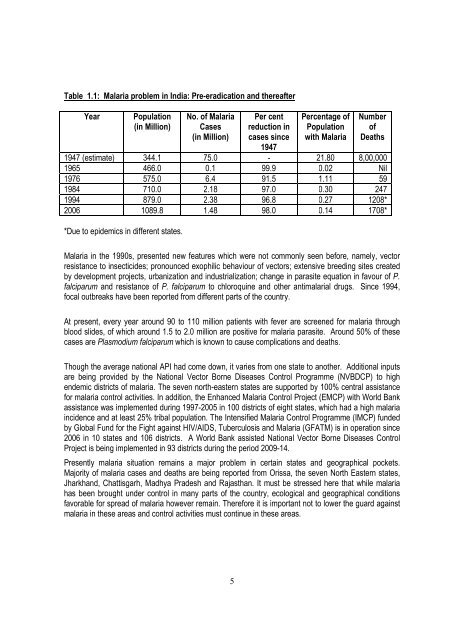training module for medical officers primary health centre - NVBDCP
training module for medical officers primary health centre - NVBDCP
training module for medical officers primary health centre - NVBDCP
- No tags were found...
Create successful ePaper yourself
Turn your PDF publications into a flip-book with our unique Google optimized e-Paper software.
Table 1.1: Malaria problem in India: Pre-eradication and thereafterYearPopulation(in Million)No. of MalariaCases(in Million)Per <strong>centre</strong>duction incases since1947Percentage ofPopulationwith MalariaNumberofDeaths1947 (estimate) 344.1 75.0 - 21.80 8,00,0001965 466.0 0.1 99.9 0.02 Nil1976 575.0 6.4 91.5 1.11 591984 710.0 2.18 97.0 0.30 2471994 879.0 2.38 96.8 0.27 1208*2006 1089.8 1.48 98.0 0.14 1708**Due to epidemics in different states.Malaria in the 1990s, presented new features which were not commonly seen be<strong>for</strong>e, namely, vectorresistance to insecticides; pronounced exophilic behaviour of vectors; extensive breeding sites createdby development projects, urbanization and industrialization; change in parasite equation in favour of P.falciparum and resistance of P. falciparum to chloroquine and other antimalarial drugs. Since 1994,focal outbreaks have been reported from different parts of the country.At present, every year around 90 to 110 million patients with fever are screened <strong>for</strong> malaria throughblood slides, of which around 1.5 to 2.0 million are positive <strong>for</strong> malaria parasite. Around 50% of thesecases are Plasmodium falciparum which is known to cause complications and deaths.Though the average national API had come down, it varies from one state to another. Additional inputsare being provided by the National Vector Borne Diseases Control Programme (<strong>NVBDCP</strong>) to highendemic districts of malaria. The seven north-eastern states are supported by 100% central assistance<strong>for</strong> malaria control activities. In addition, the Enhanced Malaria Control Project (EMCP) with World Bankassistance was implemented during 1997-2005 in 100 districts of eight states, which had a high malariaincidence and at least 25% tribal population. The Intensified Malaria Control Programme (IMCP) fundedby Global Fund <strong>for</strong> the Fight against HIV/AIDS, Tuberculosis and Malaria (GFATM) is in operation since2006 in 10 states and 106 districts. A World Bank assisted National Vector Borne Diseases ControlProject is being implemented in 93 districts during the period 2009-14.Presently malaria situation remains a major problem in certain states and geographical pockets.Majority of malaria cases and deaths are being reported from Orissa, the seven North Eastern states,Jharkhand, Chattisgarh, Madhya Pradesh and Rajasthan. It must be stressed here that while malariahas been brought under control in many parts of the country, ecological and geographical conditionsfavorable <strong>for</strong> spread of malaria however remain. There<strong>for</strong>e it is important not to lower the guard againstmalaria in these areas and control activities must continue in these areas.5
















